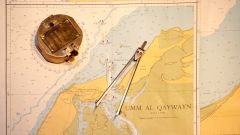You will need
- - compass;
- - protractor;
- thread;
- - my weight.
Instruction
1
In the simplest case, to determine the approximate position of the star on the horizon use the horizon. For example, the closest star to us – the Sun rises in the East and sets in the opposite direction in the West. At approximately midday the Sun is on the South side of the horizon. Therefore, sometimes it is enough to point in the direction of one side of the horizon to be able to determine the position of the desired object.
2
For a more accurate determination of the direction of the object, use the concept of azimuth. It is a expressed in degrees, the measure of the angle between the direction to the North and to the object whose position we want to determine.
3
Pick up the compass. Orient it correctly by aligning the zero division with the direction to the North. Now aim the sighting device of the compass to the point of the horizon on which the projected object in the sky. The angle between the North direction and on that point will be the azimuth by which to determine the position of the star relative to the sides of horizon.
4
Now enter another coordinate defining the height of a celestial body above the horizon. It is expressed as the angle from 0 to 90 degrees. So, if the object is right at the horizon line, its height equal to 0 degrees; if the star is directly overhead, the altitude equals 90 degrees (this point is called the Zenith).
5
To determine the height, use the normal student a protractor. To the zero point of the device, where it is supposed to be the center of the circle, attach a string with a small weight on the end. Turn the protractor so that the bottom plane it is on top. Align the protractor on a celestial object below the line of the Foundation was on the line of the light beam coming from the star to your eye.
6
Vertically located the thread with the load will indicate a specific angular value on the scale of the protractor. Subtract this value from 90 degrees, and you will receive the angle value defining the height of the object above the horizon. This parameter in conjunction with the Azimut will allow any person you will report these data to find in the heavens the object of interest.



